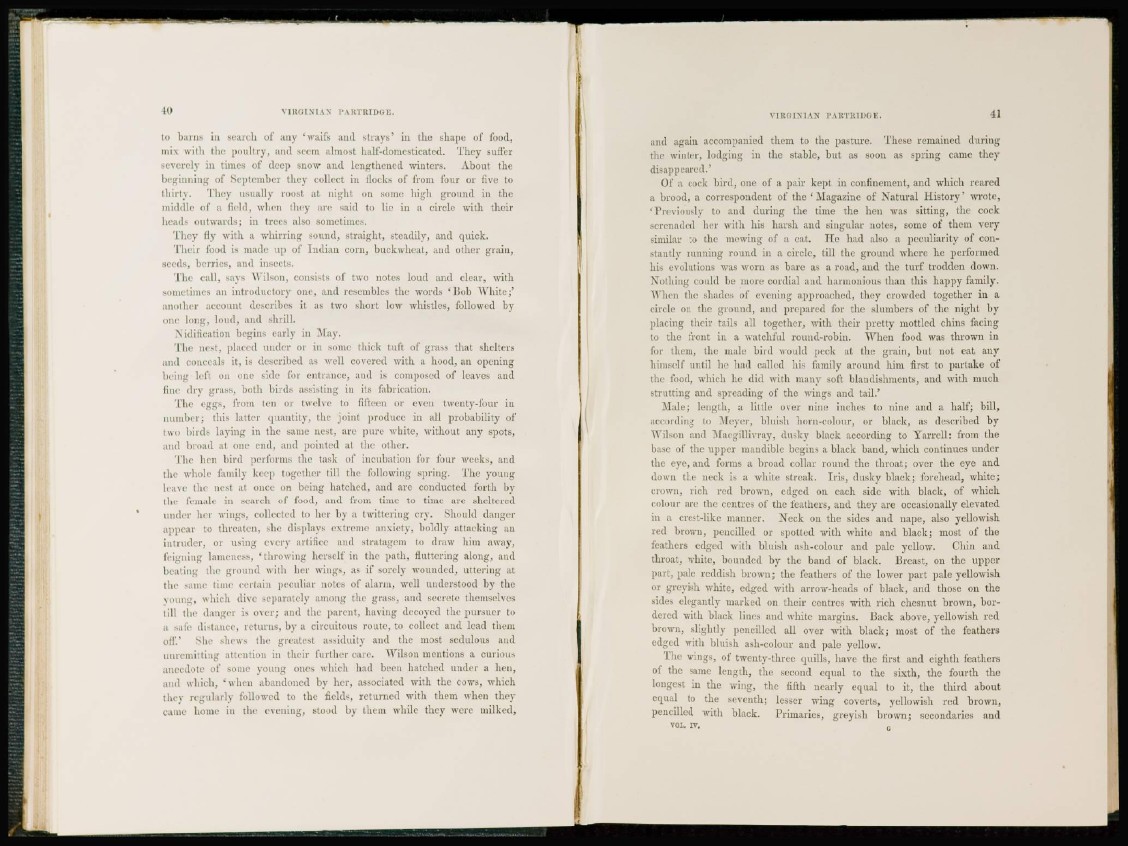
to barn-- i n search of any 'waifs and strays' in the shape of food,
mix with the poultry, and seem almost half-domes tic ated. They suffer
severely in times of deep snow and lengthened winters. About the
beginning of September they collect in flocks of from four or five to
thirtv. They usually roost at night on some high ground in the
middle of a field, when they are said to lie in a circle with their
heads outwards; in trees also sometimes.
They fly with a whirring sound, straight, steadily, and quick.
Their food is made up of Indian corn, buckwheat, and other grain,
seeds, berries, and insects.
The call, says Wilson, consists of two notes loud and clear, with
sometimes an introductory one, and resembles the words 'Bob White;'
another account describes it as two short low whistles, followed by
one Long, loud, and shrill.
Nldification begins early in May.
The nest, placed under or in some thick tuft of grass that shelters
and conceals it, is described as well covered with a hood, an opening
being left on one side Cor entrance, and is composed of leaves and
fine dry grass, both birds assisting in its fabrication.
The eggs, from ten or twelve to fifteen or even twenty-four in
number; this latter quantity, the joint produce in all probability of
two birds laying in the same nest, are pure white, without any spots,
and broad at one end, and pointed at the other.
'Idie hen bird performs the task of incubation for four weeks, and
the wdiole family keep together till the following spring. The young
Leave the nest at once on being hatched, and arc conducted forth by
the female in search of food, and from time to time arc sheltered
under her wings, collected to her by a twittering cry. Should danger
appear to threaten, she displays extreme anxiety, boldly attacking an
intruder, or using every artifice and stratagem to draw him away,
feigning lameness, ' throwing herself in the path, fluttering along, and
beating the ground with her wings, as if sorely wounded, uttering- at
the same time certain peculiar notes of alarm, well understood by the
young, which dive separately among the grass, and secrete themselves
till the danger is over; and the parent, having decoyed the pursuer to
a safe distance, returns, by a circuitous route, to collect and lead them
off.' She shews the greatest assiduity and the most sedulous and
unremitting attention in their further care. Wilson mentions a curious
anecdote of some young ones which had been hatched under a hen,
and which, 'when abandoned by her, associated with the cows, which
they regularly followed to the fields, returned with them when they
came home in the evening, stood by them while they were milked,
and again accompanied them to the pasture. These remained during
the winter, lodging in the stable, but as soon as spring came they
disappeared.'
Of a cock bird, one of a pair kept in confinement, and which reared
a brood, a correspondent of the ' M a g a z i n e of Natural H i s t o r y ' wrote,
f Previously to and during the time the hen was sitting, the cock
serenaded her with his harsh and singular notes, some of them very
similar to the mewing of a cat. He had also a peculiarity of constantlv
running round in a circle, till the ground where he performed
his evolutions was worn as bare as a road, and the turf trodden down.
Nothing could be more cordial and harmonious than this happy family.
When the shades of evening approached, they crowded together in a
circle on the ground, and prepared for the slumbers of the night by
placing their tails all. together, with their p r e t t y mottled chins facing
to the front in a watchful round-robin. When food was thrown in
for them, the male bird would peck at the grain, but not eat any
himself until he had called his family around him first to partake of
the food, which he did with many soft blandishments, and with much
strutting and spreading of the wings and tail.'
Male; length, a little over nine inches to nine and a half; bill,
according to Meyer, bluish horn-colour, or black, as described by
Wilson and Macgillivray, dusky black according to Yarrell: from the
base of the upper mandible begins a black band, which continues under
the eye, and forms a broad collar round the throat; over the eye and
down the neck is a white streak. Iris, dusky black; forehead, white;
crown, rich red brown, edged on each side with black, of which
colour are the centres of the feathers, and they are occasionally elevated
in a crest-like manner. Neck on the sides and nape, also yellowish
red brown, pencilled or spotted with white and black; most of the
feathers edged with bluish ash-colour and pale yellow. Chin and
throat, white, bounded by the band of black. Breast, on the upper
part, pale reddish brown; the feathers of the lower part pale yellowish
or greyish white, edged with arrow-heads of black, and those on the
sides elegantly marked on their centres with rich chesnut brown, bordered
with black lines and white margins. Back above, yellowish red
brown, slightly pencilled all over with black; most of the feathers
edged with bluish ash-colour and pale yellow.
The wings, of twenty-three quills, have the first and eighth feathers
of the same length, the second equal to the sixth, the fourth the
longest in the wing, the fifth nearly equal to it, the third about
equal to the seventh; lesser wing coverts, yellowish red brown,
pencilled with black. Primaries, greyish brown; secondaries and
VOL. IV.